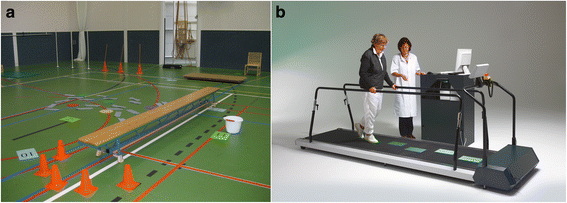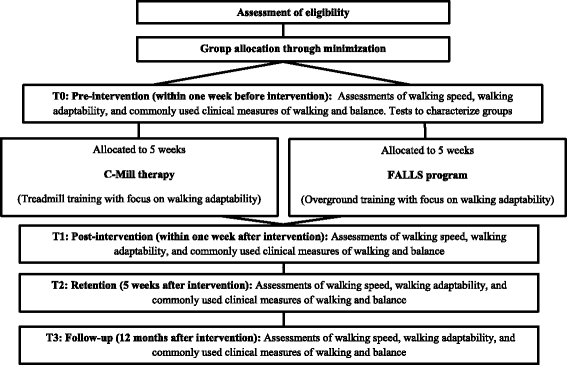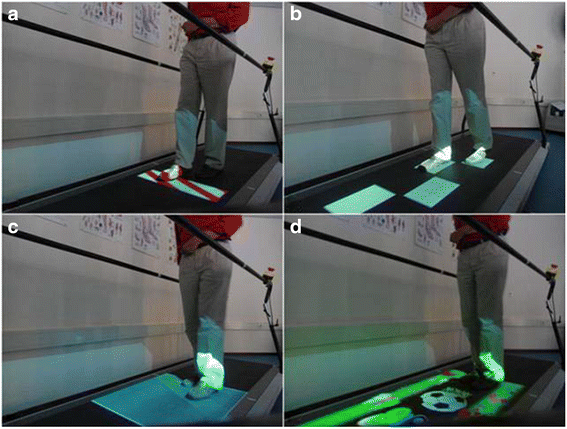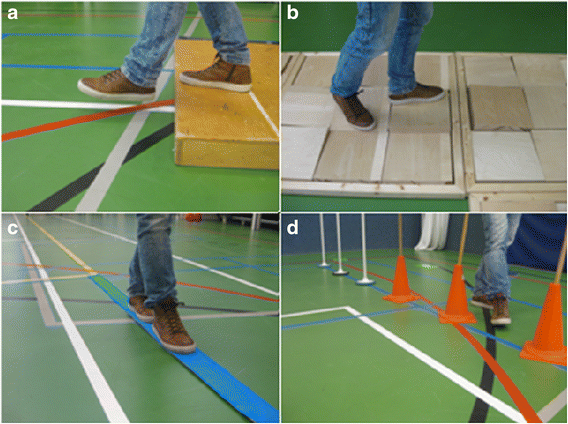Walking adaptability therapy after stroke: study protocol for a randomized controlled trial
- PMID: 27565425
- PMCID: PMC5002097
- DOI: 10.1186/s13063-016-1527-6
Walking adaptability therapy after stroke: study protocol for a randomized controlled trial
Abstract
Background: Walking in everyday life requires the ability to adapt walking to the environment. This adaptability is often impaired after stroke, and this might contribute to the increased fall risk after stroke. To improve safe community ambulation, walking adaptability training might be beneficial after stroke. This study is designed to compare the effects of two interventions for improving walking speed and walking adaptability: treadmill-based C-Mill therapy (therapy with augmented reality) and the overground FALLS program (a conventional therapy program). We hypothesize that C-Mill therapy will result in better outcomes than the FALLS program, owing to its expected greater amount of walking practice.
Methods: This is a single-center parallel group randomized controlled trial with pre-intervention, post-intervention, retention, and follow-up tests. Forty persons after stroke (≥3 months) with deficits in walking or balance will be included. Participants will be randomly allocated to either C-Mill therapy or the overground FALLS program for 5 weeks. Both interventions will incorporate practice of walking adaptability and will be matched in terms of frequency, duration, and therapist attention. Walking speed, as determined by the 10 Meter Walking Test, will be the primary outcome measure. Secondary outcome measures will pertain to walking adaptability (10 Meter Walking Test with context or cognitive dual-task and Interactive Walkway assessments). Furthermore, commonly used clinical measures to determine walking ability (Timed Up-and-Go test), walking independence (Functional Ambulation Category), balance (Berg Balance Scale), and balance confidence (Activities-specific Balance Confidence scale) will be used, as well as a complementary set of walking-related assessments. The amount of walking practice (the number of steps taken per session) will be registered using the treadmill's inbuilt step counter (C-Mill therapy) and video recordings (FALLS program). This process measure will be compared between the two interventions.
Discussion: This study will assess the effects of treadmill-based C-Mill therapy compared with the overground FALLS program and thereby the relative importance of the amount of walking practice as a key aspect of effective intervention programs directed at improving walking speed and walking adaptability after stroke.
Trial registration: Netherlands Trial Register NTR4030 . Registered on 11 June 2013, amendment filed on 17 June 2016.
Keywords: Exercise; Rehabilitation; Stroke; Therapy; Walking adaptability; Walking speed.
Figures






Similar articles
-
Walking-adaptability therapy after stroke: results of a randomized controlled trial.Trials. 2021 Dec 15;22(1):923. doi: 10.1186/s13063-021-05742-3. Trials. 2021. PMID: 34911566 Free PMC article. Clinical Trial.
-
Visually-guided gait training in paretic patients during the first rehabilitation phase: study protocol for a randomized controlled trial.Trials. 2016 Oct 27;17(1):523. doi: 10.1186/s13063-016-1630-8. Trials. 2016. PMID: 27788679 Free PMC article. Clinical Trial.
-
Visual cue training to improve walking and turning after stroke: a study protocol for a multi-centre, single blind randomised pilot trial.Trials. 2013 Sep 3;14:276. doi: 10.1186/1745-6215-14-276. Trials. 2013. PMID: 24004882 Free PMC article. Clinical Trial.
-
High Intensity Exercise for Walking Competency in Individuals with Stroke: A Systematic Review and Meta-Analysis.J Stroke Cerebrovasc Dis. 2019 Dec;28(12):104414. doi: 10.1016/j.jstrokecerebrovasdis.2019.104414. Epub 2019 Sep 27. J Stroke Cerebrovasc Dis. 2019. PMID: 31570262
-
Clinical Practice Guideline to Improve Locomotor Function Following Chronic Stroke, Incomplete Spinal Cord Injury, and Brain Injury.J Neurol Phys Ther. 2020 Jan;44(1):49-100. doi: 10.1097/NPT.0000000000000303. J Neurol Phys Ther. 2020. PMID: 31834165 Review.
Cited by
-
Automatized, Standardized, and Patient-Tailored Progressive Walking-Adaptability Training: A Proof-of-Concept Study.Phys Ther. 2019 Jul 1;99(7):882-892. doi: 10.1093/ptj/pzz013. Phys Ther. 2019. PMID: 31087062 Free PMC article.
-
Dual-Task Walking in Challenging Environments in People with Stroke: Cognitive-Motor Interference and Task Prioritization.Stroke Res Treat. 2018 May 2;2018:7928597. doi: 10.1155/2018/7928597. eCollection 2018. Stroke Res Treat. 2018. PMID: 29854381 Free PMC article.
-
Validation of the Malta Gait Scale: A Time-Efficient Tool for Poststroke Assessment.Stroke Res Treat. 2025 Mar 27;2025:8849857. doi: 10.1155/srat/8849857. eCollection 2025. Stroke Res Treat. 2025. PMID: 40182650 Free PMC article.
-
A Taxonomy for Augmented and Mixed Reality Applications to Support Physical Exercises in Medical Rehabilitation-A Literature Review.Healthcare (Basel). 2022 Mar 30;10(4):646. doi: 10.3390/healthcare10040646. Healthcare (Basel). 2022. PMID: 35455824 Free PMC article. Review.
-
Proprioceptive and Dual-Task Training: The Key of Stroke Rehabilitation, A Systematic Review.J Funct Morphol Kinesiol. 2022 Jul 7;7(3):53. doi: 10.3390/jfmk7030053. J Funct Morphol Kinesiol. 2022. PMID: 35893327 Free PMC article. Review.
References
Publication types
MeSH terms
Associated data
LinkOut - more resources
Full Text Sources
Other Literature Sources
Medical

